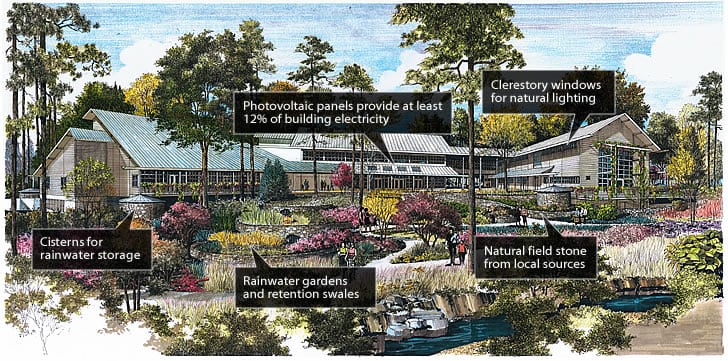So what is the Maryland “Stormwater Act of 2007” and why should you care?
The intent is to fundamentally change how rainwater (aka “Stormwater”) runoff is handled on a building lot for new residences, commercial, industrial projects, etc. Some of the concepts actually take us back to methods used over one hundred years ago!
Here is a brief run down on what I have learned
The Act is intended to improve the quality of the water that flows into Chesapeake Bay and its tributaries – I think that we can all agree that the Bay is a precious resource.
The concept grew out of a joint effort of the Maryland Department of the Environment and the Stormwater Consortium, a network over 40 environmental groups that have concerns over the water quality of the Chesapeake Bay such as the Potomac Conservancy, Maryland Chapter of the Sierra Club and the Chesapeake Environmental Protection Association.
Changing the Culture?
A Core principle established by this group has been to “develop an Environmental Site Design (ESD) Ordinance that Truly Changes Local Codes and Culture”. The use of the word “Culture” is very significant here.
 The essence of the Act was to adopt a universally different (I won’t use the word “new”) approach to the management of rainwater runoff throughout Maryland. To quote the CORE ENVIRONMENTAL SITE DESIGN PRINCIPLES of the consortium from a white paper it produced in January of 2008, ESD “is to mimic natural systems as rain travels from the roof to the stream through combined application of a series of practices throughout the entire development site. The objective of ESD is to replicate forest hydrology and water quality following land development”. This includes a lot of stuff, but here are a few things:
The essence of the Act was to adopt a universally different (I won’t use the word “new”) approach to the management of rainwater runoff throughout Maryland. To quote the CORE ENVIRONMENTAL SITE DESIGN PRINCIPLES of the consortium from a white paper it produced in January of 2008, ESD “is to mimic natural systems as rain travels from the roof to the stream through combined application of a series of practices throughout the entire development site. The objective of ESD is to replicate forest hydrology and water quality following land development”. This includes a lot of stuff, but here are a few things:
- Preserve priority forests and reforestation of turf areas
- Require narrower streets, permeable driveways, clustering lots
- Capture, store, infiltrate or re-use rooftop runoff (remember the concept of cisterns?)
- Create of long multi-cell forested wetlands
I found the rendering above on the UNC at Chapel Hill Botanical Garden website. Many of the concepts that are in the “Act” are shown.
Sounds like no more big holding ponds for mosquito breeding. Although I haven’t dug into this yet, it does appear that the costs to implement these programs will likely be much more expensive and of course will end up being added to the costs of new construction.
Once the Act was signed into law in April of 2007, there was a lot of work that had to be done to establish guidelines and policies – all of which will to come together Tuesday, May 4, 2010.
These approaches will truly change the existing governmental codes and the “culture” of how rainwater runoff is handled – your new home will no longer just have a gutter and a downspout, but an entirely integrated mini rainwater storage system.
Having a Grandfather is Good!
The scary part of this for the real estate development community was not necessarily the EDS Design Principles, but how it would impact projects that have been adhering to the current standards, after investing thousands of dollars by following the governments’ rules up to now. The last minute scurrying that many local jurisdictions are dealing with has to with providing existing projects with a grandfathering exemption.
The question that I’ll touch on this Tuesday addresses transition from the old policy to the new. So one more post on Tuesday on this topic and then on to other more interesting stuff!
